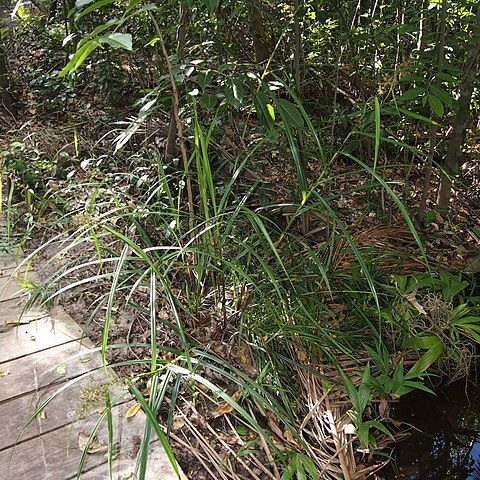Perennial. Stems slender to very robust, erect or scrambling over bushes and then up to a height of several meters, glabrous to pubescent, more or less scabrous, up to 12 mm thick in the lower part. Leaves all scattered, gradually narrowed into a very long tip, (2-)5-20(-40) mm wide, margins and not rarely the nerves scabrous; sheaths more or less widened upwards, glabrous or pubescent, scabrid, often 3-winged, the wings not rarely narrow or absent; contraligule short, rounded, with a brown, scarious margin, glabrous or ciliate. Inflorescence very variable in size, consisting of up to 4 distant partial panicles; peduncles single at the nodes, usually distinctly exserted from the sheaths, scabrid; primary bracts overtopping the inflorescence, secondary ones long, setaceous. Spikelets unisexual, solitary or 2-3 together; ♂ spikelets lanceolate, 3-4 mm long; stamens 3; anthers linear, 1-2 mm long; ♀ spikelets broadly ovate, 3½-4½ mm long, the ♂ part reduced to a sterile glume. Disk shortly 3-lobed; lobes appressed, short, rounded, sometimes slightly denticulate at the top, ferrugineous or yellow, purplish striolate. Nut ovoid or subglobose, terete to rather distinctly trigonous in the upper part, um-bonulate, smooth to cancellate, often minutely hairy when young, glabrescent, shining, white or finally purplish or blackish, 2½-3 by 2-3 mm.
A small sedge plant. It keeps growing from year to year. It has a woody underground stem or rhizome. The shoots are in tufts. They can be 60-200 cm tall. They are 3-6 mm thick. The leaves are 4-20 mm wide. The flower panicles are compound and in groups of 4. They are 10-50 cm long. The nut is oval and 3 mm long.


